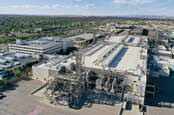Comment The US once led the world in the development and manufacturing of semiconductors and integrated circuits. And the $280 billion US CHIPS and Science Act sought to reestablish the country as a semiconductor manufacturing superpower and alleviate reliance on foreign fabs.
Two years after the massive funding bill was passed, Intel’s ambitious foundry strategy is in doubt following yet another executive shakeup and calls to spin off the ailing manufacturing unit.
Intel may have been central to efforts to establish a domestic alternative to foreign fabs, but it’s not the only major US chipmaker to fit the bill.
While Intel waits to chart a new course following former-CEO Pat Gelsinger’s sudden departure last year, US memory champion Micron is already well on its way to positioning itself to take on its larger rivals SK Hynix and Samsung Electronics.
Unlike Intel, which has yet to prove the commercial viability of its mass market process tech, Micron has already demonstrated the ability to produce leading-edge memory modules. And while substantially smaller than its South Korean competitors, it still ranks among the largest memory vendors in the world.
With more than $6 billion in US CHIPS Act funding committed to its cause, Micron is pressing forward with an aggressive plan to expand its manufacturing capacity.
To date, Micron has pledged upwards of $100 billion to scale up fab capacity across New York, Idaho, and Virginia over the next 20 years. In its latest announcement last week, Micron revealed plans to spend $2.17 billion to expand its memory plant in Manassas, Virginia, a project it now expects to rake in another $275 million in CHIPS funding, up to $70 million in state funds, and even more in tax-breaks.
And while Samsung Electronics and SK Hynix have also secured CHIPS act funding, neither companies have disclosed plans to manufacture memory modules at these plants. Samsung’s Taylor, Texas plant is slated to produce logic chips based on 4nm and 2nm process technologies. SK Hynix, meanwhile, plans to invest $3.87 billion in a memory packaging facility in West Lafayette, Indiana.
Why memory matters
Memory has taken on a new importance over the past years on account of, you guessed it: AI.
Memory modules take many forms ranging from the NAND flash used in thumb drives and SSDs to the DRAM used in system memory for everything from smartphones to notebooks.
Micron controls somewhere between 20 and 25 percent of the DRAM market and just under 12 percent of the NAND flash market.
However, in 2025, everyone’s eyes are on a specific subset of DRAM called high-bandwidth memory (HBM), which is an essential component to the GPUs and AI accelerators at the heart of the generative AI boom. The higher capacity and the more bandwidth these modules are capable of delivering, the faster these chips can run ever larger models.
Here, Micron lags its larger rivals by a wide margin having lost ground due to its decision to skip the HBM3 generation and jump straight to HBM3e which is only now making its way onto the market in products like Nvidia’s H200.
According to the industry watchers at TrendForce, between 2022 and 2024, Micron’s share of the HBM market fell from around 10 percent to 5.1 percent. SK Hynix and Samsung currently sit at 52.5 percent and 42.4 percent, respectively.
Despite this, Micron’s says it’s already sold out of HBM through late 2025, with CEO Sanjay Mehrotra optimistic the company will continue to grow its share in 2025.
Weathering the geopolitical storm
Even with billions of dollars in CHIPS Act grants at its disposal, Micron remains at the center of a geopolitical storm.
Not long ago, China accounted for more than half of the chipmaker’s revenues. That figure has slipped precipitously in recent years after Beijing banned Micron products over vague “security risks caused by hidden product problems,” in an apparent act of retaliation for US sanctions levied against YMTC.
But while Micron was among the first to suffer collateral damage as a result of the US-China trade war, it may not be the last.
In December, the Biden administration specifically targeted HBM in its latest salvo of the trade war. Under the new rules, the latest in the US crusade to stall Chinese AI development, HBM vendors will need to obtain special permission from the US Commerce Department to sell HBM in the region. It remains to be seen how big an impact this will have on HBM heavyweights SK Hynix or Samsung.
Further complicating the situation is incoming president Donald Trump who is due to make his return to the White House later this month. The President-elect has made it no secret he isn’t a fan of the CHIPS act or foreign chipmakers, like TSMC, which have profited from it.
During an appearance on the Joe Rogan Experience podcast ahead of the election, Trump condemned the CHIPS Act, calling it “so bad,” and attacked Taiwan. “They stole our chip business,” Trump said.
Shortly after Speaker of the House Mike Johnson suggested the GOP would likely move to repeal the $280 billion funding bill. Johnson quickly walked back the comments after Republican congressman Brandon Williams of New York praised Micron’s investments in New York and said he wouldn’t support efforts to undermine the investment.
Johnson later suggested there could be “legislation to further streamline and improve the primary purpose of the bill — to eliminate its costly regulations and Green New Deal requirements.”
In the wake of the comments, the Biden administration has wasted little time formally awarding the CHIPS Act subsidies to recipients. But these subsidies represent only a fraction of the CHIPS and Science Act’s value, with the majority coming in the form of a 25 percent tax credit on advanced semiconductor manufacturing facilities.
On the flip side, Trump’s comments regarding foreign chipmakers and his administration’s “America-First” agenda suggest Micron along with other US chip companies could be spared any revisions to the bill once he takes office.
The president-elect’s agenda includes leveling tariffs on imports from allies and rivals alike with the goal of spurring domestic manufacturing by making it more expensive to build products using foreign goods.
Tariffs on South Korean goods could drive US chip companies like AMD and Nvidia, which make extensive use of HBM in their products, to Micron. While this might be to Micron’s benefit – assuming it can scale capacity fast enough – the consensus, as we’ve previously discussed, is that tariffs will simply result in higher prices for end customers. ®













